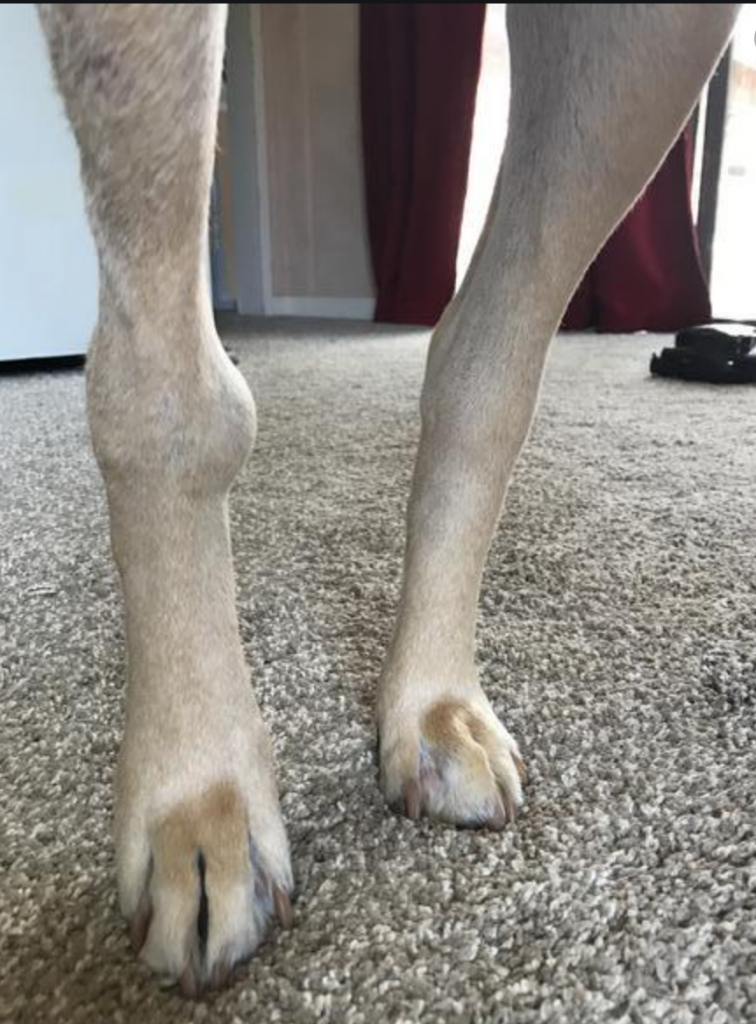Lyme disease often does not present with the same clinical signs in humans and animals. Humans show clinical signs of infection with Lyme disease within several days to several weeks following a bite from a tick. On the other hand, most dogs who are infected with Lyme disease test positive but show no clinical signs. Only 10% of infected dogs will show clinical signs typically 2-5 months after infection. Therefore, the absence of clinical signs in dogs does not mean absence of infection with Lyme disease. If a tick has bitten your dog and you don’t it attached to your dog’s skin until 36 hours or more after, it is important to consider getting your dog screened for Lyme disease to make a diagnosis start treatment. This is why tick checks immediately following outdoor activities is so important! Additionally, pet owners should not wait to see clinical signs commonly associated with humans in their pets before getting them tested for Lyme Disease infection.
People should consider getting tested for Lyme Disease upon seeing the Erythema migrans and other clinical signs, or after finding a tick attached to their skin more than 36 hours after ending an outdoor activity . Appropriate antibiotic treatment will be needed, and in some human patients, Lyme Disease can persist for months even after treatment with antibiotics. Furthermore, Lyme Disease can often be misdiagnosed as another disease in both animals and humans, so the appropriate screening is important in diagnosing and then receiving treatment. Thus, it is important for animals and humans to get tested and treated for the disease, and then be monitored by a veterinarian and/or your doctor after treatment.
Clinical Signs of Lyme Disease in Humans and Pets
| HUMANS | BOTH | PETS |
| 1. “Bull’s eye” or other shaped Erythema migrans skin rash in 70-80% of people. 2. Clinical signs typically appear in 3-30 days. 3. Fever, chills, headache, fatigue, muscle/joint aches, swollen lymph nodes. 4. More advanced Lyme disease: headaches, neck stiffness, loss of muscle tone, droop on side of face, tendon/bone pain, heart palpitations, arrhythmia, dizziness, shortness of breath, brain and spinal cord inflammation, nerve pain, and shooting pain, numbness, or tingling in the hands or feet. 5. 10-20% of people treated with antibiotics for Lyme disease can develop Post-Treatment Lyme Disease Syndrome, where symptoms of pain and fatigue can persist for months post-treatment. | 1. Fever, lethargy, enlarged lymph nodes. 2. Joint pain (in advanced human cases, especially in the knees, and most cases in dogs). 3. Some clinical signs are relatively non-specific, so Lyme disease infection can be misdiagnosed as a different disease. | 1. Many dogs that test positive for Lyme disease are not clinically ill and do not appear clinically ill. 2. Only 10% of dogs infected with Lyme disease will develop clinical illness. 3. Clinical signs typically appear 2-5 months after infection. 4. Lameness, swollen joints, fever, loss of appetite, kidney problems, lethargy, enlarged lymph nodes. |


Links for More Information
For more information on HUMAN CLINICAL SIGNS of Lyme Disease: https://www.cdc.gov/lyme/signs_symptoms/index.html and https://www.lymedisease.org/lyme-basics/lyme-disease/symptoms/
For more information on Post-Treatment Lyme Disease Syndrome in Humans: https://www.cdc.gov/lyme/postlds/index.html
For more information on a Study Exploring Post-Treatment Lyme Disease Syndrome in Dogs, which is less established or understood: https://www.ncbi.nlm.nih.gov/pmc/articles/PMC2708393/
For More information on CLINICAL SIGNS IN DOGS with Lyme Disease:
- https://www.boehringer-ingelheim.us/news/news/lyme-disease-dogs-5-things-pet-owners-should-know
- https://www.mspca.org/angell_services/lyme-disease-in-dogs/#:~:text=If%20your%20dog%20does%20develop,treatment%20with%20Doxycycline%20or%20Amoxicillin.
- https://www.merckvetmanual.com/dog-owners/disorders-affecting-multiple-body-systems-of-dogs/lyme-disease-lyme-borreliosis-in-dogs
- https://www.akc.org/expert-advice/health/lyme-disease-in-dogs/